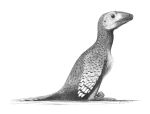Deinonychus
2007 Schools Wikipedia Selection. Related subjects: Dinosaurs
| iDeinonychus |
||||||||||||||||||||||
|---|---|---|---|---|---|---|---|---|---|---|---|---|---|---|---|---|---|---|---|---|---|---|
 Model of a Deinonychus skull.
|
||||||||||||||||||||||
| Scientific classification | ||||||||||||||||||||||
|
||||||||||||||||||||||
|
|
||||||||||||||||||||||
| Deinonychus antirrhopus Ostrom, 1969 |
Deinonychus ( IPA: [dai.ˈna.ni.kəs]) meaning 'terrible claw' ( Greek δεινος meaning 'terrible' and ονυξ/ονυχος meaning 'claw') was a 7-10 foot long, carnivorous dromaeosaurid dinosaur species from the Early Cretaceous Period. Its name refers to the unusually large, sickle-shaped talon (on the second toe of each hind foot), which was probably held retracted while the dinosaur walked on the third and fourth toes. It was commonly thought that Deinonychus would kick with the sickle claw to slash at its prey but recent tests on reconstructions of similar Velociraptor talons suggest that the claw was used to stab, not slash. Like with all dromaeosaurids the tail was stiffened by a series of ossified tendons. This might have given Deinonychus greater balance and turning ability.
Discoveries
Based on the association of a number of Deinonychus skeletons in a single quarry — several hundred Deinonychus bones were discovered by paleontologist John Ostrom and Grant E. Meyer in 1964 in southern Montana — it has been speculated that Deinonychus lived and hunted in packs. Shed teeth of Deinonychus are often found alongside skeletons of the ornithopod dinosaur Tenontosaurus, indicating that it fed on them, and perhaps hunted them. John Ostrom named and described Deinonychus, and the discovery of this clearly active, agile predator did much to change the scientific (and popular) conception of dinosaurs and open the door to speculation that dinosaurs may have been warm-blooded.
Several years later, Ostrom noted similarities between the 'hand' of Deinonychus and that of birds, which observation led him to revive the hypothesis that birds are descended from dinosaurs. Thirty years later, this idea is almost universally accepted. In fact, Deinonychus and other dromaeosaurids are so birdlike that there has been debate whether they are in fact true birds. Finds of related dinosaurs from China, such as Sinornithosaurus and Microraptor indicate that this dinosaur may have borne feathers. Other relatives include Velociraptor, Utahraptor, and Dromaeosaurus.
Specimens
A skeleton of Deinonychus can be seen on display at the American Museum of Natural History or the Harvard Museum of Comparative Zoology. The American Museum and Harvard specimens are from a different locality than the Yale specimens, which Ostrom described and the claws are different shapes (Ostrom 1976). This raises the possibility that the two are, in fact, different species or even different genera.
- Skull length: 410 mm (16.4 in)
- Total length: 3 m (10 ft)
- Hip height: 1.2 m (4 ft)
- Weight: 80 kg (175 lb)
In popular culture
While Deinonychus itself never appeared in any of the Jurassic Park books or films, the supposed Velociraptor in the films actually more closely resemble Deinonychus in size and shape. This was due to the fact that Gregory S. Paul, in his book Predatory Dinosaurs of the World, concluded that Deinonychus was a species of Velociraptor and rechristened the species Velociraptor antirrhopus, a theory that has since been largely rejected. Michael Crichton continued to synonymize the two genera in his novels, on which the first two films were based.
Deinonychus is featured once in a Calvin and Hobbes comic strip. In this strip, Calvin does a report on overpopulation which involves a story about Susie Derkins being attacked and eaten by a pack of Deinonychus.
In the comic book series Runaways one of the characters received a Deinonychus which she named "Old Lace".
In the children's book series Animorphs, Rachel and Tobias both morph this dinosaur in an attempt to escape a herd of them. They succeed, and later lose the morph while returning to their own time in the present.
Deinonychus action figures were available in the Dino Riders toy-line.
Talon from Primal Rage is based on a Deinonychus.

